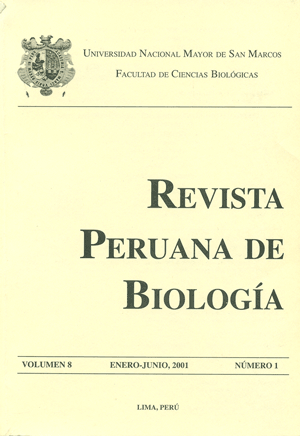Use of somatic coliphages as indicators of faecal pollution in beaches of "La Costa Verde", Lima-Peru
DOI:
https://doi.org/10.15381/rpb.v8i1.6534Keywords:
faecal pollution, indicators, somatic coliphages, recreational seawater, water quality.Abstract
This study was undertaken in order to assess the use of somatic coliphages as faecal pollution indicators in recreational seawater. In 140 samples from 5 beaches at the “Costa Verde” circuit, Lima, somatic coliphages were enumerated and correlated with conventional faecal pollution indicators (Faecal coliforms, E. coli and enterococci). After sample treatment with the “Sample Filtration” modified technique, somatic coliphages were assayed by the “Single-Agar-Layer” method using the strain E. coli C ATCC 13706 as the bacterial host. Faecal coliforms (FC) E. coli (EC) and enterococci (EN) were enumerated by the Most Probable Number method. In the statistical analysis, we took into account faecal pollution levels based on arbitrary values such as <1000 CF/100 mL (“Low pollution”) and 1000 FC/100 mL (“High pollution”). The beaches surveyed showed faecal pollution levels from <3 to 2,4 x 105 to both FC and from EC, and <3 to 2,4 x 104 EN. In samples with “low pollution” the 32% of coliphage´s counts were greater than those of FC and EC, whereas on samples with “High pollution” no count was bigger than any of FC and EC. On the other hand, according with the principal component analysis, coliphages and enterococci were the best indicators of faecal pollution in the surveyed beaches. Furthermore, statistically significant correlations were determined between somatic coliphages with FC and EC; being greater on samples with “High pollution” (r = 0,89) than those in samples with “low pollution” (r = 0,43). From coliphages determination in the samples evaluated it was determined the value of 115 UFP/100 mL as a guideline for recreational seawater in the beaches under study. According with the results of this study, the somatic coliphages could be used as alternative faecal pollution indicators in recreational seawater.Downloads
Downloads
Published
Issue
Section
License
Copyright (c) 2001 Hinsby Cadillo Quiroz, Jorge León Quispe

This work is licensed under a Creative Commons Attribution-NonCommercial-ShareAlike 4.0 International License.
AUTHORS RETAIN THEIR RIGHTS:
a. Authors retain their trade mark rights and patent, and also on any process or procedure described in the article.
b. Authors retain their right to share, copy, distribute, perform and publicly communicate their article (eg, to place their article in an institutional repository or publish it in a book), with an acknowledgment of its initial publication in the Revista Peruana de Biologia.
c. Authors retain theirs right to make a subsequent publication of their work, to use the article or any part thereof (eg a compilation of his papers, lecture notes, thesis, or a book), always indicating its initial publication in the Revista Peruana de Biologia (the originator of the work, journal, volume, number and date).






